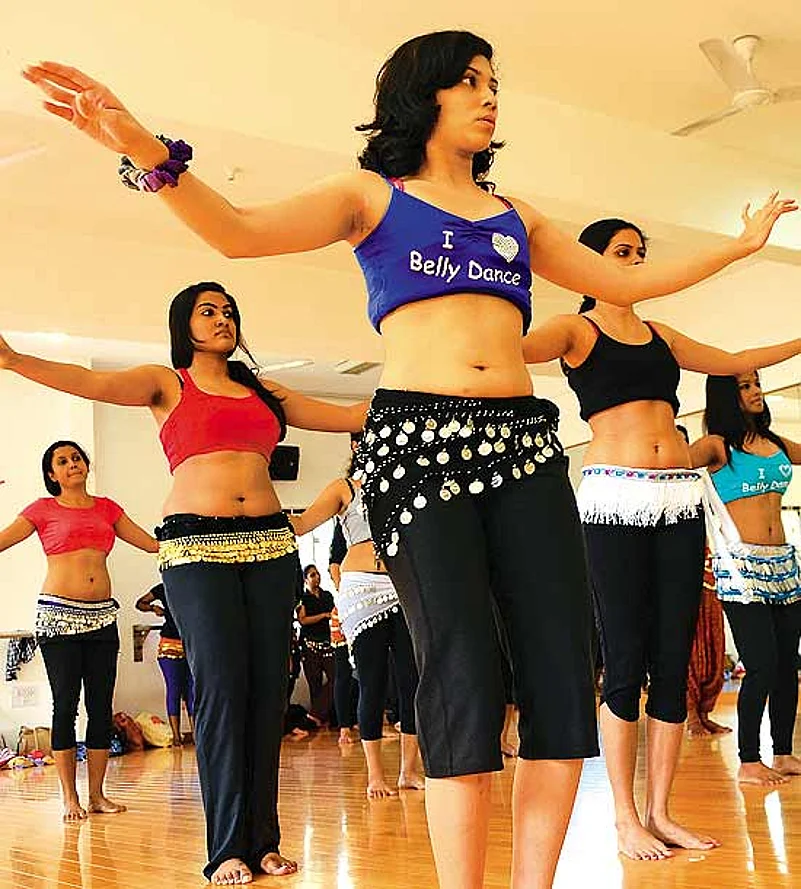Those rhythmic hip drops, malleable belly rolls, suggestive shimmies and bone-defying undulations. Shakira may have emphasised how the hips don’t lie, but the belly dance still leaves us mesmerised and wondering just how its practitioners do it. And it’s no longer just alluring belles from Alexandria or Ankara confounding us; 65 ladies in Ludhiana partook of a week-long belly dancing workshop last month, during the Punjab International Latin Festival. The traditional West Asian dance, raqs sharqi, has found its way into classrooms, dance academies and festivals from Jabalpur to Bangalore and is now not only being sold as a professional art form, but also as a great way to keep fit.

She charges Rs 2,000 for eight hours of classes a month. It may seem steep, but Meher flaunts an impressive resume. A familiar face on reality shows like India’s Got Talent and Just Dance, she has a big following of fans and eager pupils. In Bangalore, Sanaz Bakhtiari has had over 2,000 students come to her Sanaz Dance Studio. “Five years ago, I had only four or five students,” she says. “Now, there’s also fusion dancing. It has some yoga asanas added to it, but nothing can equal the authentic version.”
Apart from the physical rigour, teaching—or even learning—the belly dance has its own set of problems. Not every parent is enthused about their daughter opting for a dance form that most people relate with the filmi cabaret sequence or dance bars, when they could be learning traditional styles like Bharatanatyam or Kathak, or even ballet. Samiksha Chhabra comes all the way from Panipat to Delhi on weekends to learn belly dancing. Her parents were initially opposed to her decision, but relented when she stood her ground. Samiksha’s case shows how the trend is catching on even in small towns. Sapna Khandelwal, who runs a dance, music and arts academy in Jabalpur, had 40 students enrol for a workshop conducted recently by the Banjara School of Dance. What do the girls who come here want to go on to do? “I want to become a dancer and go abroad to perform. Shakira and Rani are my role models,” says Divya Aale, a student at the academy.
For many others, it is just one more way to stay fit. Sangeeta Kushwaha, who runs three dance studios out of Ludhiana, says most of her students find it an exciting way to stay in shape. “There are about 400 women learning in Ludhiana through workshops conducted by trained dancers. It has numerous health benefits—strengthens hips, lower back and abdominal and pelvic muscles, ensures fewer complications during child birth and is de-stressing.” Essa, a Canadian who heads the Diva Bellydance Academy in Pune, goes one better. She says it’s the best exercise for a woman, where the mind and body become stronger. She focuses on the dance’s health benefits; the roughly 3,000 women who have attended her classes feel likewise. Belly dancing is often seen as a meeting point between the East and West, the variations in it such as the Turkish cabaret style, Egyptian classical, Lebanese pop, the Russian style, influenced by ballet, American tribal, fusion and gothic and folk styles makes it a wide-ranging dance form.

Pratik Chaudhri from Jaipur. (Photograph by Sanjay Rawat)
Even established dancers acknowledge the growing craze in India for the belly dance. Najma Asani, who runs the Danza Orientale institute in Italy, feels India is becoming more aware of the form. When teaching and performing in Delhi last year, she realised how interested people were to learn authentic belly dancing. “Soon it won’t just be a profession, but also a distinct art form.”
Shakira brought the zing back to belly dancing with her chartbusters. Earlier, the Bond flick, The Man With the Golden Gun, had belly dancer Saida sport a spent bullet in her navel, while the Beatles attempted conversation with a belly dancer at a restaurant in Help! But how many instances of male belly dancers can you recount? What has primarily been a women-dominated dance form, now has some men stepping into the arena in India. Pratik Chaudhri from Jaipur, who has done a diploma course in classical ballet and modern dance, thinks the movements are natural, aesthetic and intricate. His fiancee Eesha Singh, also a belly dancer, quickly refutes any idea that the dance is only for women. “We still live in a patriarchal society where there are social stigmas associated with male dancers. One should be broad-minded.” College student Arun Kumar has a point to prove. Focused on becoming a trained belly dancer, he hopes to encourage more men to participate and break the stereotype.

Shake it all about! Belly dancing class in session at the Life and Dance studio in Pune. (Photograph by Vikram Patwardhan)
Akanksha Gupta, an instructor at the Banjara School of Dance, thinks it’s not so much personal success that drives her as the desire to make the dance more acceptable in India. “I had to coax my parents to let me do it. I feel confident now and am totally addicted to it. There’s no way I can step down.” Krishnendu Dey, an avid fan from Calcutta, is hooked onto dance videos online and loves everything about belly dancing—from choreography to attire to movements. “I can’t get my mind off it,” he says. Meher Malik sums it up. “We don’t believe in cheap entertainment. Our intention is to bring about a change in people’s perceptions and stick to what is authentic.” The stigma attached to belly dancing may already be slipping off.















